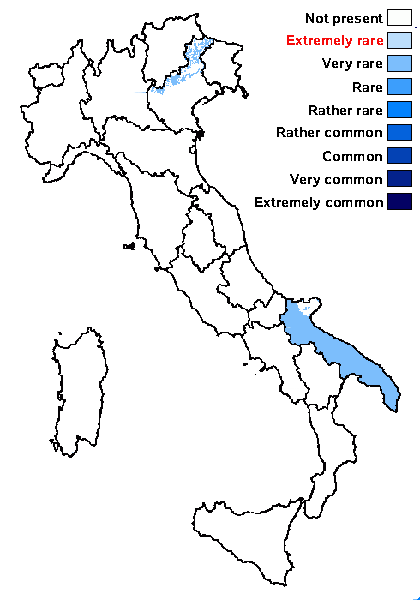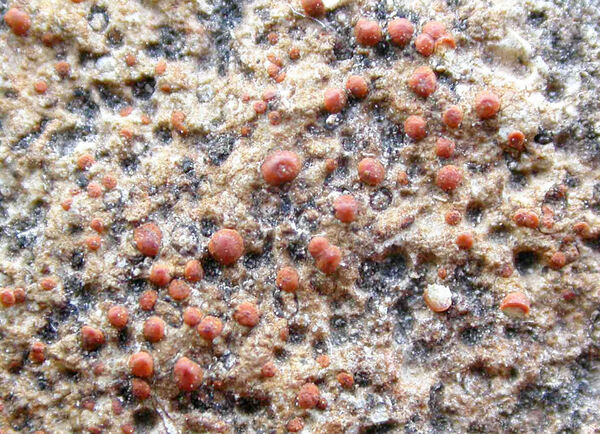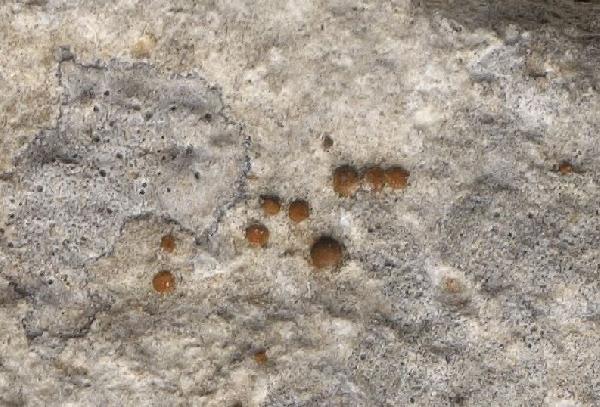Protoblastenia lilacina Poelt & Vězda
in Vezda, Cas. slezsk. Mus. Opave, A 19: 26, 1970.
Synonyms: Biatora rupestris var. sanguinea Arnold; Protoblastenia calva var. sanguinea (Arnold) Cl. Roux; Protoblastenia rupestris var. sanguinea (Arnold) Zahlbr.
Distribution: S - Pugl (Kainz & Rambold 2004).
Description: Thallus crustose, endosubstratic or more rarely thinly episubstratic, continuous or finely cracked, whitish or pale grey, most often inconspicuous. Apothecia c. 40-100/cm2, 0.2-0.6 mm across, sessile to immersed in the lower fourth, not constricted at base, rarely leaving shallow pits in the rock when they fall off, with a convex, ochraceous orange, often pruinose disc and a very thin, soon excluded proper margin. Proper exciple poorly developed, of branched, parallel-radiating hyphae, colourless or patchily pale orange; epithecium orange-brown, 12-20 µm high, reacting K-, K+ darkening orange or K+ wine-red (not releasing a K+ purple-red solution); hymenium colourless to pale orange, inspersed with oil droplets, (50-)85-120 µm high; paraphyses coherent, sparingly branched and anastomosing, 2-3 µm thick at mid-level, the apical cells slightly swollen, up to 3.5 µm wide; hypothecium colourless, yellowish or often purplish red, patchily pigmented, inspersed with oil droplets, 60–120 μm high. Asci 8-spored, clavate, with a well-developed, amyloid tholus containing a more intensely amyloid, indistinct tube structure, without an ocular chamber, approximating the Porpidia- or Psora-types. Ascospores 1-celled, hyaline, broadly ellipsoid to ovoid, (8.5-)11-14(-17) x (5-)6-7.5(-8) μm, without a distinct perispore. Photobiont chlorococcoid. Spot tests: thallus K-, C-, KC-, P-; apothecia K- or K+ wine-red. Chemistry: apothecia with 1-O-methylparietin.Note: a rather poorly known species of sunny calcareous rocks below the subalpine belt, reported from Finland, Germany, France, Austria, Italy, Croatia and Greece. It is characterised by the weak reaction of the apothecia to K. Material reported by Kainz & Rambold (2004) from Veneto was sequenced by Pykälä & Myllys (2025) and proved to belong to P. oulankaensis.
Growth form: Crustose endolithic
Substrata: rocks
Photobiont: green algae other than Trentepohlia
Reproductive strategy: mainly sexual
Poorly known taxon in need of further study
Commonnes-rarity: (info)
Alpine belt: absent
Subalpine belt: absent
Oromediterranean belt: absent
Montane belt: very rare
Submediterranean belt: very rare
Padanian area: absent
Humid submediterranean belt: absent
Humid mediterranean belt: absent
Dry mediterranean belt: very rare

Predictive model
Herbarium samples

http://fungi.myspecies.info/taxonomy/term/7510/media - Licence: CC BY-NC 3.0 – Photo uploaded by Mark Powell

Source: http://fungi.myspecies.info/taxonomy/term/7510/media - Licence: CC BY-NC 3.0 – Photo uploaded by Mark Powell

Detail from: https://gzu.jacq.org/GZU000291958
GZU000291958 - Vězda,A. Vězda, A.: Lichenes Selecti Exsiccati 888 Date 1969-08-17
Location Croatia / Dubrovacko-Neretvanska
Label Jugoslavia – Dalmatia, insula Korčula: Žrnova Banja ; Alt. 20 m - 30 m
Habitat Ad lapides calcareos in margine vinearum acumulatos.
Growth form: Crustose endolithic
Substrata: rocks
Photobiont: green algae other than Trentepohlia
Reproductive strategy: mainly sexual
Poorly known taxon in need of further study
Commonnes-rarity: (info)
Alpine belt: absent
Subalpine belt: absent
Oromediterranean belt: absent
Montane belt: very rare
Submediterranean belt: very rare
Padanian area: absent
Humid submediterranean belt: absent
Humid mediterranean belt: absent
Dry mediterranean belt: very rare

Predictive model
| Herbarium samples |

http://fungi.myspecies.info/taxonomy/term/7510/media - Licence: CC BY-NC 3.0 – Photo uploaded by Mark Powell

Source: http://fungi.myspecies.info/taxonomy/term/7510/media - Licence: CC BY-NC 3.0 – Photo uploaded by Mark Powell

 INDEX FUNGORUM
INDEX FUNGORUM
 GBIF
GBIF
 DOLICHENS
DOLICHENS

